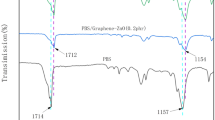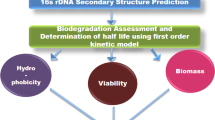Abstract
Here, the influence of graphene as a coating on the biodegradation process for two different polymers is investigated, poly(butylene adipate-co-terephthalate) (PBAT) (biodegradable) and low-density polyethylene (LDPE) (non-biodegradable). Chemical vapor deposition graphene was transferred to the surface of two types of polymers using the Direct Dry Transfer technique. Polymer films, coated and uncoated with graphene, were buried in a maturated soil for up to 180 days. The films were analyzed before and after exposure to microorganisms in order to obtain information about the integrity of the graphene (Raman Spectroscopy), the biodegradation mechanism of the polymer (molecular weight and loss of weight), and surface changes of the films (atomic force microscopy and contact angle). The results prove that the graphene coating acted as a material to control the biodegradation process the PBAT underwent, while the LDPE covered by graphene only had changes in the surface properties of the film due to the accumulation of solid particles. Polymer films coated with graphene may allow the production of a material that can control the microbiological degradation, opening new possibilities in biodegradable polymer packaging. Regarding the possibility of graphene functionalization, the coating can also be selective for specific microorganisms attached to the surface.







Similar content being viewed by others
References
Geyer R, Jambeck JR, Law KL (2017) Production, use, and fate of all plastics ever made. Sci Adv 3:e1700782. https://doi.org/10.1126/sciadv.1700782
Lebreton LCM, Van Der Zwet J, Damsteeg JW et al (2017) River plastic emissions to the world’s oceans. Nat Commun 8:1–10. https://doi.org/10.1038/ncomms15611
Amass W, Amass A, Tighe B (1998) A review of biodegradable polymers: uses, current developments in the synthesis and characterization of biodegradable polyesters, blends of biodegradable polymers and recent advances in biodegradation studies. Polym Int 47:89–144. https://doi.org/10.1002/(SICI)1097-0126(1998100)47:2<89::AID-PI86>3.0.CO;2-F
Almeida D, Peças P, Ribeiro I et al (2011) Application of life cycle engineering for the comparison of biodegradable polymers injection moulding performance. In: Hesselbach J, Herrmann C (eds) Glocalized solutions for sustainability in manufacturing SE-106. Springer, Heidelberg, pp 611–616
Bastioli C (2005) Handbook of biodegradable polymers, 1st edn. Rapra Technology Limited, Shawbury
Ozsagiroglu E, Guvenihr YA, Iyisan B (2012) Biodegradation and characterization studies of different kinds of polyurethane with several enzyme solutions. Polym J Environ Study 21:1777–1782
Tsuji H, Echizen Y, Nishimura Y (2006) Enzymatic degradation of poly(L-lactic acid): effects of UV irradiation. J Polym Environ 14:239–248. https://doi.org/10.1007/s10924-006-0023-6
Cho K, Lee J, Kwon K (2001) Hydrolytic degradation behavior of poly(butylene succinate)s with different crystalline morphologies. J Appl Polym Sci 79:1025–1033. https://doi.org/10.1002/1097-4628(20010207)79:6<1025::AID-APP50>3.0.CO;2-7
Shangguan YY, Wang YW, Wu Q, Chen GQ (2006) The mechanical properties and in vitro biodegradation and biocompatibility of UV-treated poly(3-hydroxybutyrate-co-3-hydroxyhexanoate). Biomaterials 27:2349–2357. https://doi.org/10.1016/j.biomaterials.2005.11.024
Lucas N, Bienaime C, Belloy C et al (2008) Polymer biodegradation: mechanisms and estimation techniques—a review. Chemosphere 73:429–442. https://doi.org/10.1016/j.chemosphere.2008.06.064
Novoselov KS, Geim AK, Morozov SV et al (2004) Electric field effect in atomically thin carbon films. Science 306:666–669. https://doi.org/10.1126/science.1102896
Geim AK, Novoselov KS (2007) The rise of graphene. Nat Mater 6:183–191. https://doi.org/10.1038/nmat1849
Yang Y, Asiri AM, Tang Z et al (2013) Graphene based materials for biomedical applications. Mater Today 16:365–373. https://doi.org/10.1016/j.mattod.2013.09.004
Rodriguez CLC, Kessler F, Dubey N et al (2017) CVD graphene transfer procedure to the surface of stainless steel for stem cell proliferation. Surf Coat Technol 311:10–18. https://doi.org/10.1016/j.surfcoat.2016.12.111
Pokharel P DL (2014) Thermal and mechanical properties of reduced graphene oxide/polyurethane nanocomposite. J Nanosci Nanotechnol 14:5718–5721. https://doi.org/10.1166/jnn.2014.8824
Yousefi N, Gudarzi MM, Zheng Q et al (2013) Highly aligned, ultralarge-size reduced graphene oxide/polyurethane nanocomposites: mechanical properties and moisture permeability. Composites A 49:42–50. https://doi.org/10.1016/j.compositesa.2013.02.005
Das TK, Prusty S (2013) Graphene-based polymer composites and their applications. Polym Plast Technol Eng 52:130227104444003. https://doi.org/10.1080/03602559.2012.751410
Bae S, Kim SJ, Shin D et al (2012) Towards industrial applications of graphene electrodes. Phys Scr T146:14024. https://doi.org/10.1088/0031-8949/2012/T146/014024
Fechine GJM, Martin-Fernandez I, Yiapanis G et al (2015) Direct dry transfer of chemical vapor deposition graphene to polymeric substrates. Carbon 83:224–231. https://doi.org/10.1016/j.carbon.2014.11.038
Kang J, Hwang S, Kim JH et al (2012) Efficient transfer of large-area graphene films onto rigid substrates by hot pressing. ACS Nano 6:5360–5365. https://doi.org/10.1021/nn301207d
Bae S, Kim H, Lee Y et al (2010) Roll-to-roll production of 30-inch graphene films for transparent electrodes. Nat Nanotechnol 5:574–578. https://doi.org/10.1038/nnano.2010.132
Liang X, Sperling B, Calizo I et al (2011) Toward clean and crackless transfer of graphene. ACS Nano 5:9144–9153. https://doi.org/10.1021/nn203377t
Ferreira FV, Cividanes LS, Gouveia RF, Lona LMF (2017) An overview on properties and applications of poly(butylene adipate-co-terephthalate)-PBAT based composites. Polym Eng Sci. https://doi.org/10.1002/pen.24770
Wu D, Wu L, Zhou W et al (2010) Crystallization and biodegradation of polylactide/carbon nanotube composites. Polym Eng Sci 50:1721–1733
Mohanty AK, Misra M, Drzal LT (2002) Sustainable bio-composites from renewable resources: opportunities and challenges in the green materials world. J Polym Environ 10:19–26. https://doi.org/10.1023/A:1021013921916
Potts JR, Dreyer DR, Bielawski CW, Ruoff RS (2011) Graphene-based polymer nanocomposites. Polymer 52:5–25. https://doi.org/10.1016/j.polymer.2010.11.042
Li X, Cai W, An J et al (2009) Large-area synthesis of high-quality and uniform graphene films on copper foils. Science 324:1312–1314. https://doi.org/10.1126/science.1171245
Shimizu RN, Demarquette NR (2000) Evaluation of surface energy of solid polymers using different models. J Appl Polym Sci 76:1831–1845. https://doi.org/10.1002/(SICI)1097-4628(20000620)76:12<1831::AID-APP14>3.0.CO;2-Q
Ferrari AC, Meyer JC, Scardaci V et al (2006) Raman spectrum of graphene and graphene layers. Phys Rev Lett 97:187401
Kessler F, Rocha COC, Medeiros GS, Fechine GJM (2016) Chemical vapor deposition graphene transfer process to a polymeric substrate assisted by a spin coater. Mater Res Express 3:9. https://doi.org/10.1088/2053-1591/3/3/035601
Luckachan GE, Pillai CKS (2011) Biodegradable polymers—a review on recent trends and emerging perspectives. J Polym Environ 19:637–676. https://doi.org/10.1007/s10924-011-0317-1
Shih CJ, Wang QH, Lin S et al (2012) Breakdown in the wetting transparency of graphene. Phys Rev Lett 109:1–5. https://doi.org/10.1103/PhysRevLett.109.176101
Wang S, Zhang Y, Abidi N, Cabrales L (2009) Wettability and surface free energy of graphene films. Langmuir 25:11078–11081. https://doi.org/10.1021/la901402f
Austin D, Moss MO (1986) Numerical Taxonomy of red-pigmented bacteria isolated from a Lowland River, with the description of a New Taxon, Rugamonas rubra gen. nov., sp. nov. Microbiology 132:1899–1909. https://doi.org/10.1099/00221287-132-7-1899
Kuila T, Bose S, Mishra AK et al (2012) Chemical functionalization of graphene and its applications. Prog Mater Sci 57:1061–1105. https://doi.org/10.1016/j.pmatsci.2012.03.002
Yu J, Yue B, Wu X et al (2016) The covalently organic functionalization of graphene: methodologies and protocols. Curr Org Chem 20:1284–1298
Georgakilas V, Otyepka M, Bourlinos AB et al (2012) Functionalization of graphene: covalent and non-covalent approaches, derivatives and applications. Chem Rev 112:6156–6214. https://doi.org/10.1021/cr3000412
Acknowledgements
We acknowledge funding from Fundação de Amparo à Pesquisa do Estado de São Paulo (FAPESP), grants 2012/50259-8 and 2014/22840-3. This work was also partially funded by Fundo Mackenzie de Pesquisa (MackPesquisa), grant 068/2014. Pablo A. R. Muñoz are supported by a fellowship from FAPESP (2015/16591-3).
Author information
Authors and Affiliations
Contributions
All authors reviewed, revised, commented on and approved the final version of the manuscript.
Corresponding author
Ethics declarations
Competing interests
The authors declare no competing financial interests.
Rights and permissions
About this article
Cite this article
Maldonado, L.F., Muñoz, P.A.R. & Fechine, G.J.M. Transfer of Graphene CVD to Surface of Low Density Polyethylene (LDPE) and Poly(butylene adipate-co-terephthalate) (PBAT) Films: Effect on Biodegradation Process. J Polym Environ 26, 3187–3196 (2018). https://doi.org/10.1007/s10924-018-1202-y
Published:
Issue Date:
DOI: https://doi.org/10.1007/s10924-018-1202-y




